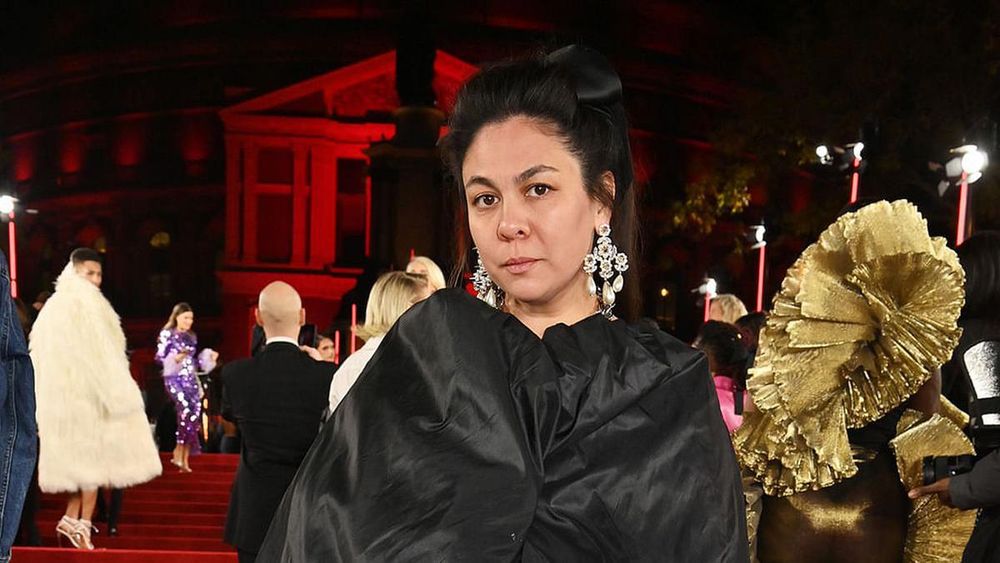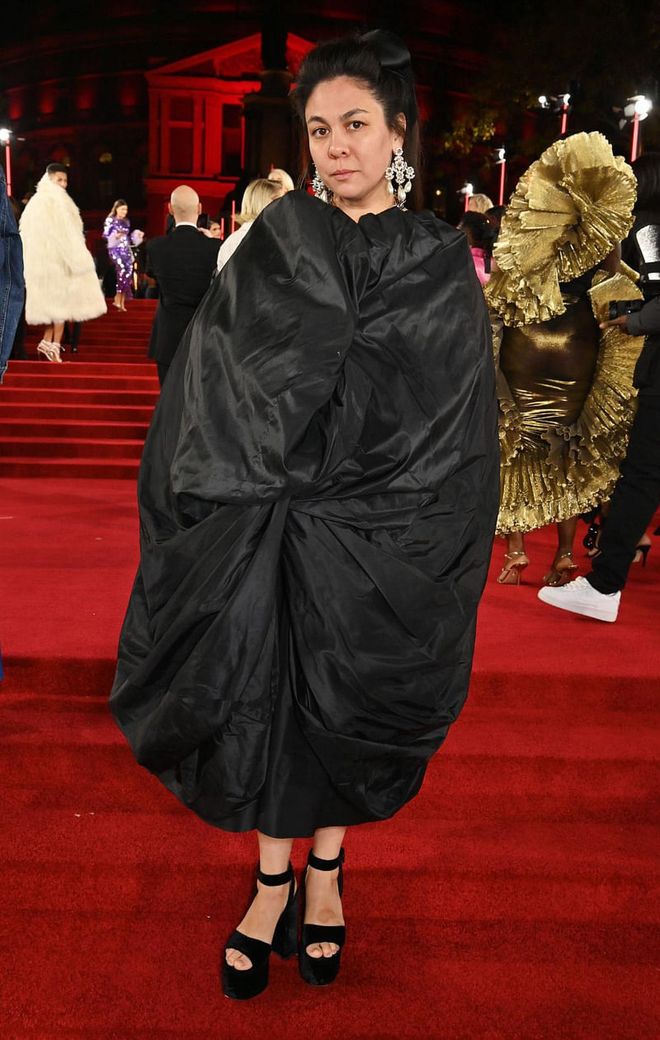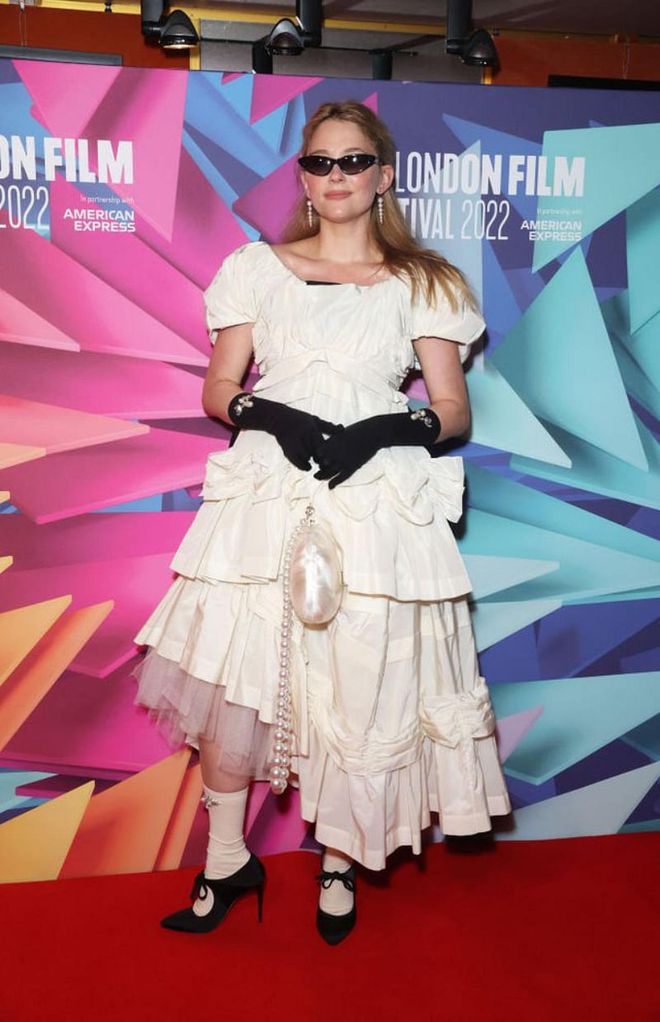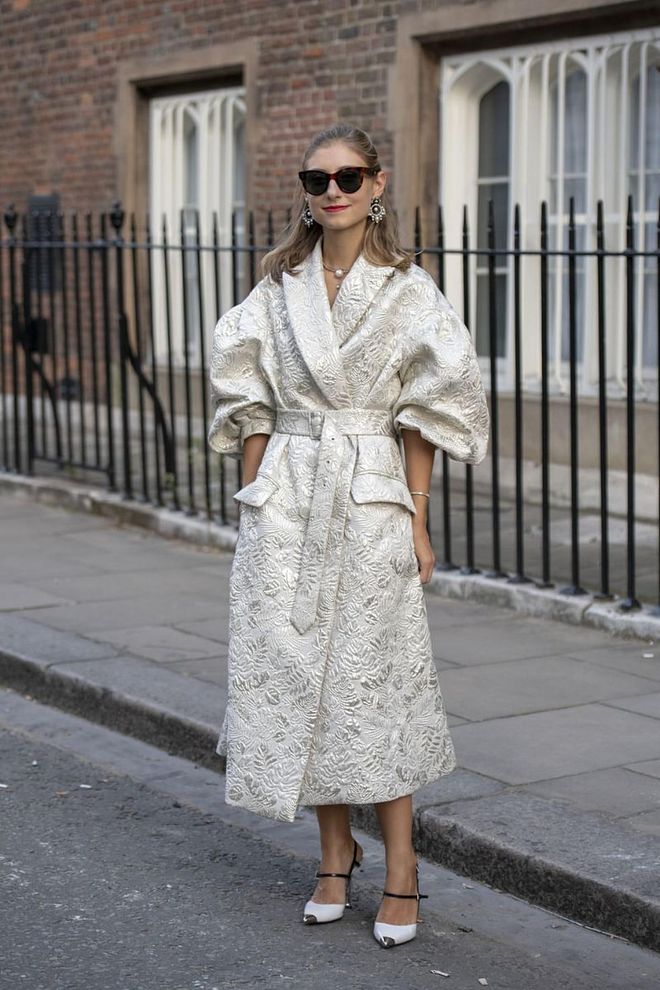Simone Rocha Talks Folklore And Fairytales In Her Fall 2023 Collection
Thirteen years into her business, the designer's inclusive approach to the codes of femininity feels more relevant than ever.


Photo: David M. Benett / Getty Images
Simone Rocha
With their diaphanous mountains of tulle, bows, and rhinestones, Simone Rocha’s clothes are the stuff of fairytales, and indeed her Fall 2023 collection, which debuts at London Fashion Week on Saturday evening, is inspired by one. “In particular, I’ve been looking to Lughnasadh”—pronounced “LOO-nuh-suh”—which is the autumn tradition in Ireland, and the rituals around it.” The idea is “this kind of teenage folklore, but set today, in this idea of realism.”
Realism is not a word that might spring to mind for pagan rituals, but Rocha is the master of the wearable fantasy, especially in this moment. Each collection, she explains, starts as a reaction to the previous show. In her beloved Spring 2023 collection, “There was something about it that felt very aerated, and it was about me harnessing that emotion. But it felt ‘up in the air.’ And this collection feels very rooted and very close to the earth.”
that has always been so integral to me—that there’s a practicality and there’s a reality. And for me, it’s that collision that has always been the way I design.” What she loves, she says, is when she can research a source of inspiration and then “translate that into clothes that, when people wear them, they feel an element of that emotion that went into the original story.”
Related article: All The Looks From Simone Rocha Spring 2023
Her clothes speak of frivolous pleasures on the surface—ribbons, swans, pink, glitter—but her shapes and fabrics allow the wearer to layer or manipulate or play with the clothes to express whatever they want. If most gender fluidity has seen designers play with masculine-coded garments like blazers, trousers, and button-downs, Rocha challenges norms with what’s deemed “feminine” to create a picture of eccentric strength. The clothes can come “from this ephemeral, feminine, emotional place, but when it’s on your body, I do see it as a security, or a uniform, or an armor. It doesn’t have to be hard, and that can be fragile and that can be tactile. But there’s a real security in clothing to me.”

Haley Bennett in a Simone Rocha look, including beaded socks and opera gloves and an egg-like purse. (Photo: David M. Benett / Getty Images)
Haley Bennett in a Simone Rocha look, including beaded socks and opera gloves and an egg-like purse.
Rocha founded her brand in 2010, showing at London Fashion Week, and has been one of the city’s marquee stars since. (She was born in Ireland, and speaks with a lemony accent; her father is Chinese-Irish designer John Rocha.) She has been one of Moncler’s Genius designers, making ribbon-festooned shell jackets and shiny black puffers that looked gothically adorable; she also created a collaborative line with H&M, in the spring of 2021, which “triggered online meltdowns” when it went on sale. Her clothes are intelligent without being pretentious, and frilly without being fussy. In fact, their voluminous silhouettes and layers of garments belie that they’re remarkably easy to wear. She might make a see-through slip, for example, that can be worn over a glittering white cable knit bralet and knickers, or over a pair of trousers and button-up shirt. The clothes can be as demure or erotic as the wearer chooses. The stylist Haley Wollens attended a dinner party late last year wearing a sheer tulle collar with nothing underneath.
Related article: Hair Accessories Are Going Nowhere, As Simone Rocha Proved

Jenny Walton wearing a Simone Rocha coat. (Photo: Kristin Sinclair / Getty Images)
Jenny Walton wearing a Simone Rocha coat.
Though her brand is into its second decade of existence, and has an admirably consistent aesthetic, the fandom for Rocha’s work has increased exponentially over the past three years. The support around her brand resembles that of Rick Owens or Comme des Garçons, where dedicated customers and editors alike arrive at her show wearing Simone Rocha head-to-toe. Shoppers who have her pieces in their wardrobe often find things as varied as a ruffled pencil skirt or a bomber with heart cut-outs to be an unexpected workhorse. And for a certain kind of millennial or Gen Z artist, who works primarily in a medium outside of fashion but follow it ravenously like a subculture, Rocha is like Prada—the brand to wear to signal an in-the-know attitude about femininity, gender, and art. Photographer Quil Lemons, filmmaker Janicza Bravo, and illustrator Jenny Walton are all regularly spotted in Rocha’s clothes.
“I always knew what I did was very specific to me and myself as a designer,” she says. “And with that, I always knew that it wouldn’t be for everybody. I was always very comfortable living with that. And I think with that, you then attract people that also have a kinship with that.
“But then,” she continues, stifling a laugh, “ultimately people that have always felt like the outsiders actually have all these insiders.”
Rocha traces the more recent excitement to the brand to her H&M collaboration, released amid the pandemic. “And when that opened up, remotely all these people felt part of our community and our world when we were so detached,” she says. “It was really eye-opening. And I think that also gave me more confidence to really stand proud of everything we do and the collaborations we do, [which] bring people together, essentially.” That kinship around the brand is what “in the last few years has been really pushing me forward,” she says.
But it also seems that her clothing taps into, or is a worthy vessel for, shifts happening in fashion and identity that radiate beyond her line. Though she formally introduced menswear in the Spring 2023 collection now appearing in stores, her clothes have always felt inclusive even at their most feminine. She thinks about the artist Louise Bourgeois, an artist who has long inspired her (a number of Bourgeois’s artworks can be seen in Rocha’s stores around the world). “Her work was always so personal, but when you saw it, it felt personal to you,” she says. “And that’s how I feel about clothes. I think it’s a real relationship between what you put on your body and yourself. I think it is so personal. And these are all facets of being a woman, you know what I mean? Or being a human, even. And I think that's what I find very interesting: dissecting that and putting that into, essentially, a dress or a skirt, or a t-shirt or a shirt or a piece of knitwear.”
If gender-fluid dressing has been a prevailing conversation in fashion and style over the past three years, large fashion brands (and major celebrities) at times struggle to articulate what that might mean, tiptoeing around the associations of “male” or “female” clothing. (See: the accusations that Harry Styles, in his Gucci pussybow blouses, is “queerbaiting.”) Rocha’s clothes exist in a realm outside that. “I don’t know if I think of gender when putting on clothing anymore, especially hers!” Lemons, the photographer, tells me. Lemons describes her clothes as “elegant” rather than fragile: “When I wear Simone Rocha I feel extremely powerful. I love when people can’t understand the look!”
“The clothing is very disruptive actually,” he continues. “Simone is crafting conversation while making clothing asking the question—why tf not! It’s punk! It’s a respectful fuck-you to tradition! Menswear is so boring. I’m happy she’s allowing more room for play and exploration! If you get it you get it. If you don’t, you don’t.”

The actress Stephanie Hsu attending a BAFTA event in January, wearing a Simone Rocha dress from the Spring 2023 collection. (Photo: Monica Schipper / Getty Images)
The actress Stephanie Hsu attending a BAFTA event in January, wearing a Simone Rocha dress from the Spring 2023 collection.
Related article: Exclusive: Simone Rocha Is The Latest Designer To Collaborate With H&M
Rocha is one of a cohort of designers—many of them women—who see their roles not as authoritative creators of trends or ideas, but more like empaths who provide the tools or palette for their customers to express themselves. It’s up to the wearer to style the clothes in a way that makes them feel comfortable, confident, or mysterious (or something else entirely). Designers like Tory Burch and Maryam Nassir Zadeh also come to mind here, for their collections that present convertible or modular pieces that feel open to interpretation.
Rocha seems to have developed a language in which bows and ruffles are divorced from their fussy or frivolous associations. Or perhaps it’s that Rocha values the frivolity, seeing it as equally important and valid as heavy shoulders or precise tailoring. “I love the history of” something like a bow or ruffle or pearl, she says. “And then actually dissecting it and looking at, actually, what was that archetype? Was that even right? Is that how that made women feel in that time? What pearls were associated with? And then actually, if we put them in the context of today, and if you look at them as a stone from the sea and what that natural thing does, it completely changes it from how, when I was in school, people would go to rugby matches and girls wear pearl earrings with rugby shirts. It’s breaking down the ideas. And just interpreting them in a way that has a kinship to the reality of femininity or masculinity today.”
This article originally appeared on Harper's BAZAAR US.